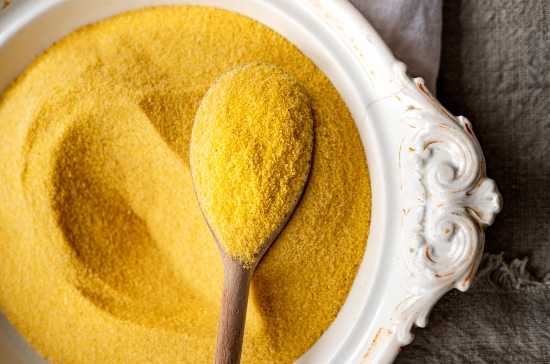
. Sweet polenta ideas from Biagio d’Angelo .
As freely translated from Italian. . .
” Many objects of the senses go apparently unnoticed during childhood and adolescence, or so it seems. Over time, memories play an interesting part on experience, and ingredients of the past take on a different meaning. To tell you the truth, I have had a special relationship with an unassuming fruit, namely the quince.
My mother adored them! I remember well how she would avidly work in the kitchen with my father to make quince marmalade and the famous Sicilian “cotognata”, a thick sweet paste preserved in decorative shapes. I also remember how my brother and I looked woefully at the seemingly endless supply of both, because honestly we didn’t like either . . . they were perhaps too sweet and sticky for our youthful taste in food.
But time has changed all that. When I happened upon some fresh quince at the market (an unusual sight in Brazil, I assure you), despite their exorbitant price, I had to take some home. I dedicated my quince acquisition to the making of a polenta cake, adapted from a recipe by Irina Georgescu. This dessert combines two very popular Romanian ingredients. It makes for a beautifully, moist cake which is neither too sweet or too rich. Lina’s recipe is beyond delicious and I know my mother would love it. Too bad we are so far away from each other in the middle of a pandemic. . .
Ingredients for the batter . for a cake tin 18cm in diameter
- 200 grams of unsalted butter
- 150-200 grams of granulated or raw cane sugar
- 3 large eggs
- 200 grams finely ground almonds
- 100 grams fine cornmeal for polenta
- 25 ml rapeseed oil
For the quince marmalade
- 1 quince . approximately 400 grams
- 200 ml water
- 75 grams sugar
- 50 ml honey
For the syrup
- The juice of two oranges . approximately 350-400 ml
Prepare the cake tin by rubbing it generously on all sides and bottom with unsalted butter, or simply cover it with a piece of well-fitting parchment paper. Preheat the oven to 170 degrees Celsius, with the fan on.
To make the marmalade, wash the quince, then peel it and remove the seeds as well as the core. Slice the fruit into cubes. Bring the fruit, water, honey and sugar to a boil in a sauce pan at medium heat. Allow the fruit to simmer until the quince is very soft and the sugars have thickened, about 20 minutes. Smash the fruit with a fork until it looks like coarse apple sauce, then set it aside.
Meanwhile, to make the syrup, simmer the orange juice five minutes in a sauce pan at medium heat, stirring occasionally. Then set aside.Prepare the cake batter as follows.
Toast the almonds, then grind them into a fine powder. Cut the butter into a cubes. In a mixer or a food processor, mix the sugar and butter two-four minutes into a smooth cream. With the machine running, add one egg at a time until they are assimilated. To finish the batter, stir the ground almonds, cornmeal and rapeseed oil until just incorporated into the butter mixture.
Spoon the quince marmalade one the bottom of the cake tin, then pour in the batter. Bake the cake 50-55 minutes, or until cooked when tested with a fork or a cake skewer. Remove the cake from the oven and allow it to cool ten minutes. Tip the cake onto a platter. Warm the orange syrup, then carefully prick holes all around the cake with a skewer. Pour the syrup over the top of the quince marmalade and serve the cake while still warm. If you have any leftovers (which you might not haha), warm the cake in a preheated oven at 150 degrees Celsius for about 5 minutes, before bringing it to the table.
Sincerely, Biagio .
author of gloggtheblog.com ”











 Zuppa is the Italian name for soup made with a mixture of vegetables, cooked in broth. The word zuppa can also describe any general mix-up of things outside the soup bowl or the kitchen for that matter . . . such as a chaotic meeting or a confusing conversation for example . . . It is derived from the word inzuppare which literally translates as to drench or to soak.
Zuppa is the Italian name for soup made with a mixture of vegetables, cooked in broth. The word zuppa can also describe any general mix-up of things outside the soup bowl or the kitchen for that matter . . . such as a chaotic meeting or a confusing conversation for example . . . It is derived from the word inzuppare which literally translates as to drench or to soak.